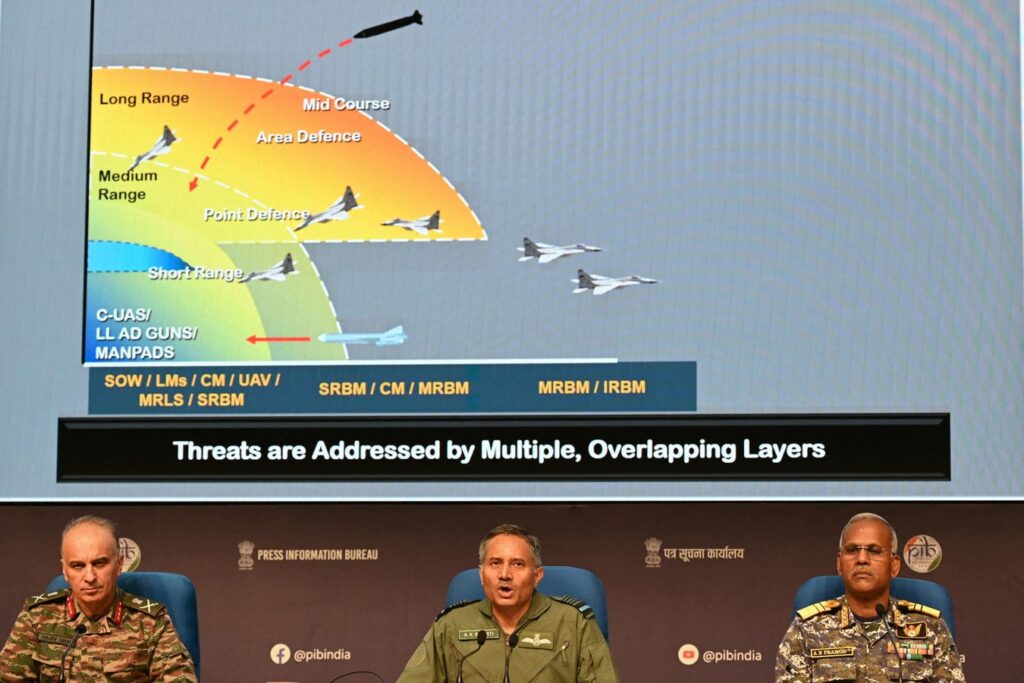Indian Army Director General of Military Operations Lt. Gen. Rajiv Ghai (L), Indian Airforce Air … More
As India and Pakistan prepared for conflict over the last month, they revealed the next evolution of intimidating war rituals that once included banging shields and intimidating dances: the deployment of electronic warfare systems. In addition to tanks and artillery, this move reflects the new face of modern warfare, where combat extends into the electronic domain.
As seen in the Russia-Ukraine war, EW technology has a decisive impact on the battlefield. These systems interfere with a range of electronic signals, including those used for communications, radar, and navigation. They typically block GPS signals, jam the control links to drones and missiles, disrupt ground and air communications, and weaken the radar that supports air-defense networks. By placing EW systems along the border, both India and Pakistan made a show of force while reducing the other’s ability to conduct offensive and defensive operations.
Indian And Pakistani Electronic Warfare Assets
NEW DELHI, INDIA JANUARY 26: The HT-16 electronic warfare system on display during the 73rd … More
Tensions rapidly escalated between these two nuclear powers following the Pahalgam massacre on April 22, when 26 Indian tourists were killed in Indian-controlled Jammu and Kashmir by militants linked to Pakistan. India made the initial move, deploying several systems along the border. India’s main EW system is the Samyukta system, which consists of 145 vehicles and covers an area of 150 kilometers by 70 kilometers. Developed domestically in 2004, the system is capable of electronic surveillance, direction finding, and jamming both communication and radar signals. India has other EW weapons in their arsenal including the Himshakti, a jamming system for mountainous terrain, and the Spectra suite, which is integrated into their Rafale fighter aircraft.
Pakistan Air Force J-10C fighter jets perform at a rehearsal ahead of Pakistan’s national day parade … More
Pakistan quickly responded by moving its own EW systems into forward positions. Many of its assets are Chinese-supplied, including the DWL-002 passive detection system. Unlike traditional radar, it detects and tracks airborne threats by picking up their electronic signatures. Pakistan also deployed several Chinese-made commercial-grade GPS jammers intended to disrupt Indian drones and missiles. Additionally, the Pakistani J-10C fighter aircraft carry advanced EW equipment, which reportedly disrupted the control systems on Indian Rafale aircraft flying along the border on April 29.
Strategic Goals Of Deploying Electronic Warfare Systems
While it may seem unusual for countries to showcase their EW capabilities in this way, such deployments are consistent with modern military doctrine. Given the long-standing hostility between India and Pakistan, both militaries have established a layered air-defense network designed to stop aircraft and missiles, as well as artillery intended to block ground advances. These defenses typically include EW systems, which are commonly used for detecting and disrupting incoming missiles and aircraft.
NEW DELHI, INDIA – MAY 11: Director General of Military Operations (DGMO) Lt General Rajiv Ghai with … More
Meanwhile, EW has become the preferred method for breaking through these layered defenses. It can interfere with the radar systems that support air-defense networks, which are then targeted and destroyed by air and missile strikes. Once the adversary’s air defenses are neutralized, a military gains temporary air dominance, enabling it to carry out further missile and air strikes with minimal resistance. EW systems also disrupt communications, making it difficult for adversaries to coordinate a response, issue warnings, or mount a counteroffensive. Furthermore, the deployment of these systems carries a psychological impact. They are expensive and typically kept secret, so their visible deployment signals that a significant attack may be imminent.
The Impact of Electronic Warfare On The Conflict
KASHMIR, INDIA – 2025/05/07: Residents look at a wreckage of an unknown aircraft in Wuyan area of … More
Both countries had their EW equipment tested on May 7, when India launched a series of air and missile strikes into Pakistan. Pakistan responded with its own set of strikes. Although the true effectiveness of these systems is unclear, both India and Pakistan have made claims that their EW systems played key roles in the conflict. The Indian military claims that they successfully jammed the Pakistani air defense systems, as reported by Times of India, allowing the Indian Air Force to strike its targets in Pakistan. Meanwhile, Pakistan has made claims that the EW systems on their J-10C aircraft contributed to the downing of Indian Rafale aircraft.
As seen in the Russia-Ukraine war, the recent India-Pakistan conflict further highlights the growing role of electronic warfare in shaping military outcomes. While aircraft and missiles carried out the physical strikes, India’s offensive operations relied heavily on the effective use of EW systems. Pakistan’s defense similarly leveraged its own EW systems. These systems have become essential elements of the modern battlefield, offering capabilities as important as armor and artillery.
Read the full article here
